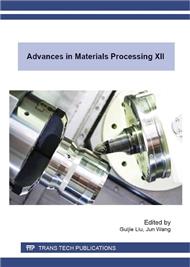p.90
p.97
p.102
p.108
p.115
p.121
p.127
p.133
p.141
Surface Morphology of Silicon Induced by Laser Ablation in Flowing Water
Abstract:
Underwater laser machining process has a high potential over the typical laser ablation to remove materials with less thermal damage occurring along the cut. However, the formations of vapor bubble and cut debris in water can substantially disturb the incident laser beam, thereby reducing the ablation performance. Instead of performing the ablation in still water, the flowing water technique was applied to flush away the cut debris and bubble generated. In this study, the effects of laser pulse energy, traverse speed and water flow rate on the cut surface roughness and heat-affected zone in the laser grooving of silicon were experimentally investigated and analyzed. The findings revealed that the cut surface roughness decreased with the increases in laser pulse energy and laser traverse speed. Though a higher water flow rate resulted in a rougher cut surface, the heat-affected zone can be minimized when the increased flow rate was applied.
Info:
Periodical:
Pages:
115-120
Citation:
Online since:
July 2016
Authors:
Price:
Сopyright:
© 2016 Trans Tech Publications Ltd. All Rights Reserved
Share:
Citation:


